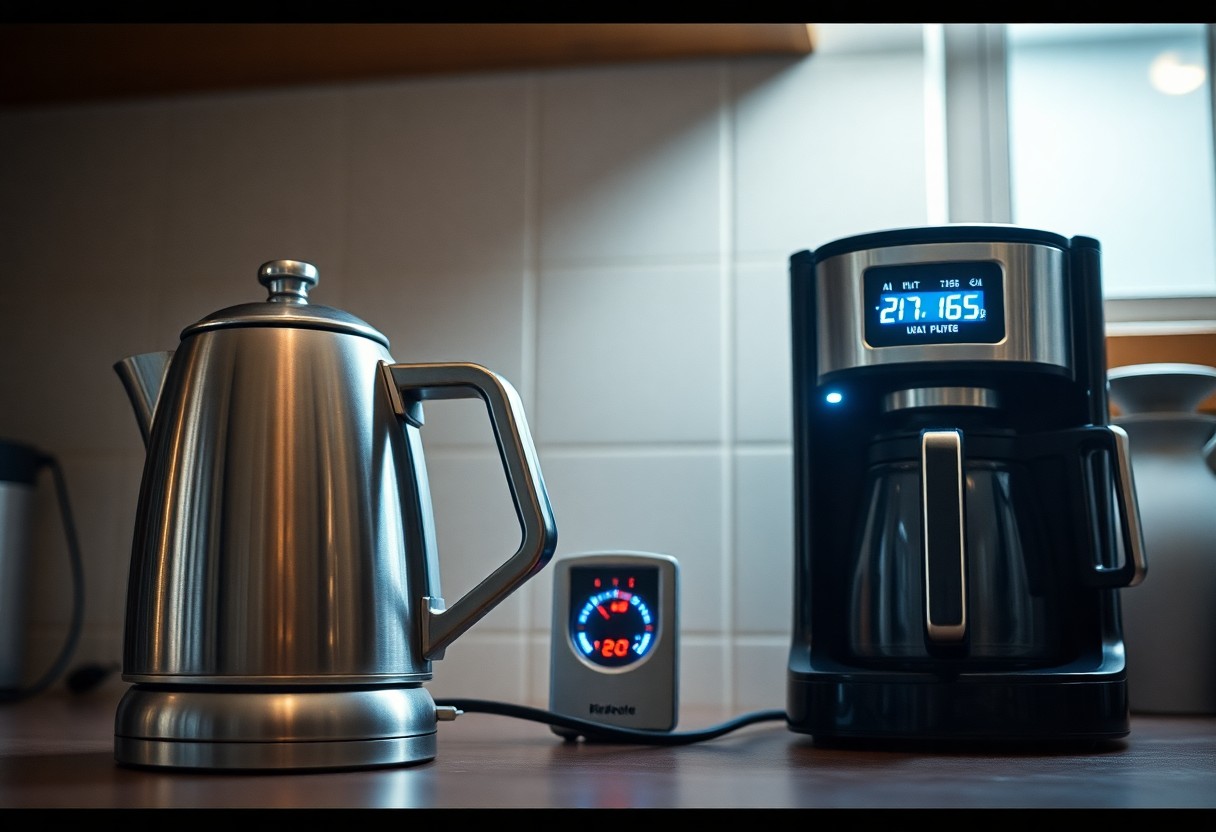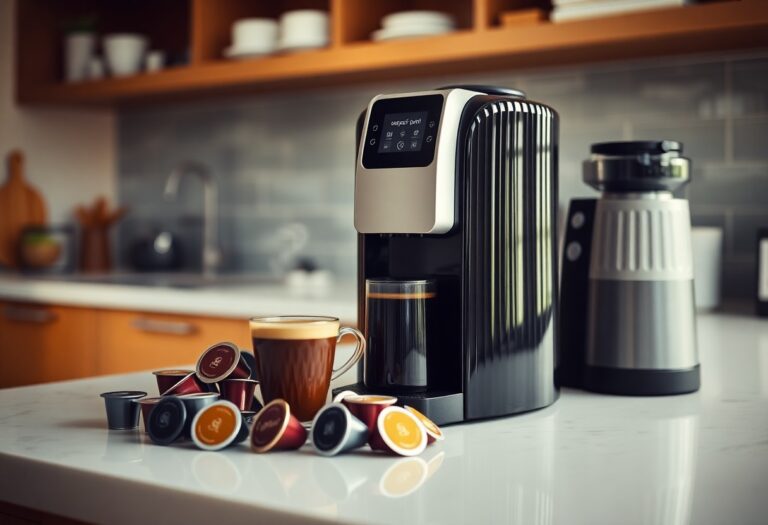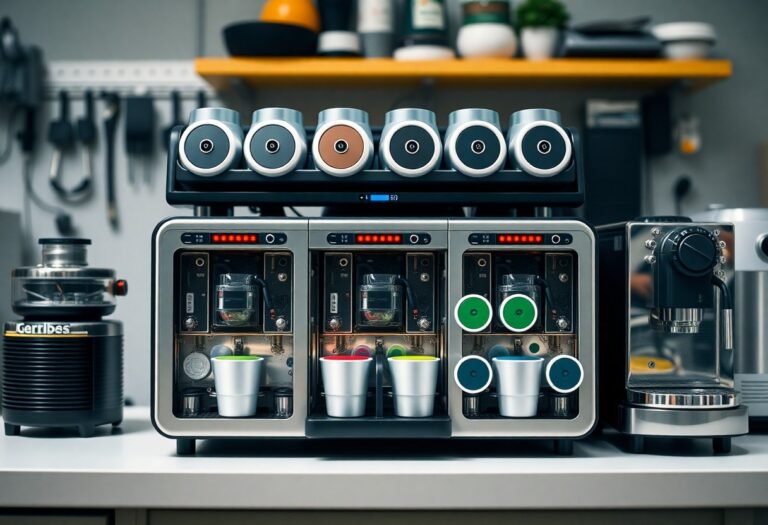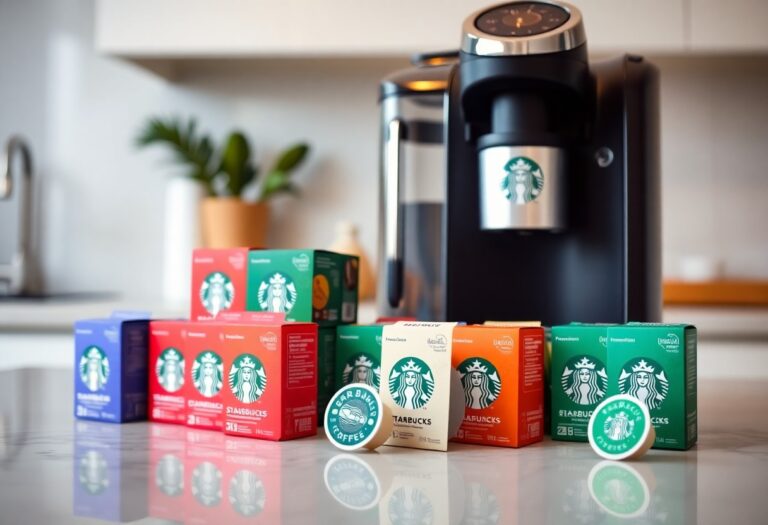What Uses More Electricity Kettle or Coffee Machine – Energy Comparison
Most people rely on either a kettle or a coffee machine for their daily caffeine fix, but have you ever wondered which one consumes more electricity? Understanding the energy consumption of each appliance is necessary not only for reducing your utility bills but also for making environmentally friendly choices. In this detailed comparison, you will uncover the energy usage of both kettles and coffee machines, enabling you to optimize your usage and ensure that your morning routine is as efficient as possible.
Key Takeaways:
- Kettles typically have a higher wattage, which means they often consume more electricity in a shorter amount of time compared to coffee machines.
- The energy use of each appliance depends on the volume of water or coffee being heated; a full kettle may use more energy than a coffee machine brewing a single cup.
- Efficiency ratings can vary; some modern coffee machines are designed to be energy-efficient, potentially reducing their overall electricity consumption.
- Heating methods differ; kettles usually boil water quickly, while coffee machines might take longer due to their brewing processes.
- Considering the frequency of use can impact overall energy costs; using one appliance more regularly could lead to higher electricity bills.
The Energy Demands of Electric Kettles
Electric kettles demand significant energy to quickly heat water for your beverages. Typically, they use between 1200 to 3000 watts, meaning they can draw a substantial amount of electricity over a short period. When boiling a standard 1.5-liter kettle, you’re looking at around 0.1 to 0.2 kWh for a single use, depending on the model and the efficiency of its heating elements. This rapid energy consumption typically results in lower overall use compared to longer-running appliances, which is a key factor in understanding your daily energy consumption.
Power Consumption Profiles
Understanding the power consumption profiles of electric kettles can illuminate how they fit into your energy usage. Most kettles use around 1500 watts when in full boil mode, leading to a quick energy spike when you flick the switch. This quick surge means that while they consume more energy in short bursts, your overall electricity spent can still be manageable, especially if used sparingly throughout the day.
Efficiency in Heating Water
The efficiency of kettles in heating water far surpasses that of many other appliances. Electric kettles can convert about 80% of the energy used into heat for water, minimizing wastage. Unlike stovetops that lose heat to the air, kettles are specifically designed to focus the energy into the water itself, leading to faster boiling times. This efficiency not only saves time but also reduces your overall electricity bill when you’re making hot drinks regularly.
Kettles achieve remarkable efficiency by utilizing modern technology, such as improved insulation and optimized heating elements. By keeping heat loss to a minimum, kettles can reduce heating times significantly. Many newer models include features like adjustable temperature settings and a boil-dry protection mechanism that enhance safety and further contribute to energy savings. With a typical boiling time of about four to six minutes for a full kettle, this combination of performance and efficiency can lead to lower energy costs on your monthly bill, especially compared to heating water for the same purpose on a traditional stove or in slower appliances.
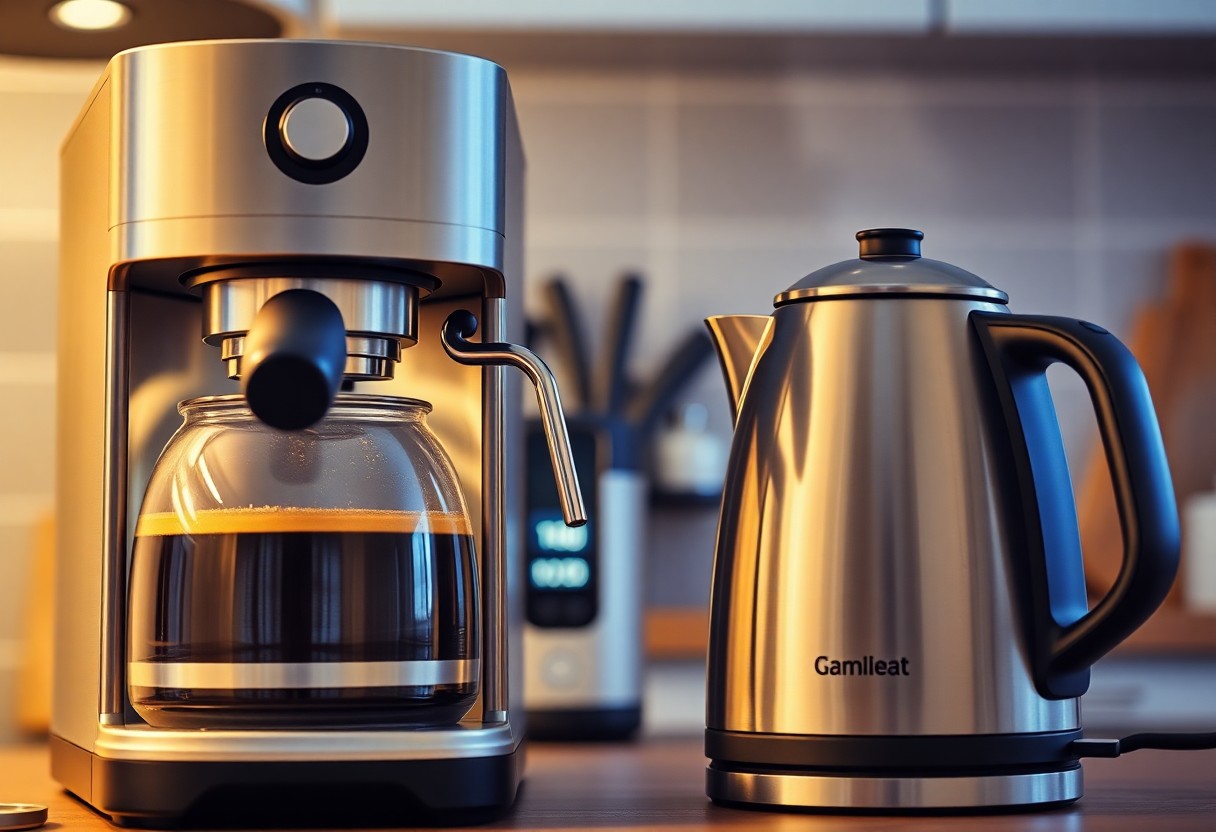
Brewing Basics: Energy Usage of Coffee Machines
Understanding the energy consumption of coffee machines helps you make informed decisions about your daily caffeine needs. A typical coffee machine uses between 600-1200 watts depending on its type and specifications. For instance, single-serve pod machines are usually at the lower end, while advanced espresso machines can draw significantly more power due to pump mechanisms and heating elements. Your coffee preparation habits, including brew time and the machine’s efficiency, play a vital role in overall energy usage.
Types of Coffee Machines and Their Wattage
- Drip Coffee Makers: 600-1200 watts
- Espresso Machines: 800-1500 watts
- Single-Serve Pod Machines: 600-1200 watts
- Coffee Percolators: 1000-1500 watts
- French Press (manual): minimal electricity use
Thou now have a clearer overview of different machines to help in your energy decisions.
The Brewing Process and Energy Efficiency
The brewing process significantly influences energy efficiency. With drip machines, the brewing time can range from 5 to 10 minutes, while espresso machines typically brew in under 30 seconds. Machines that require longer preheating times or additional features can consume more electricity. Efficiency can be improved by minimizing idle times and brewing only what you need, giving your efforts a clear benefit from an energy standpoint.
For instance, drip coffee makers that offer a programmable feature can save energy if you set them to brew right when you wake up, reducing the time spent on standby. Similarly, by choosing a coffee machine that rapidly heats water, you can cut down on the overall energy demand for each cup of coffee. Thus, it’s vital to consider the specific features of your chosen coffee machine to enhance both your coffee-making experience and energy savings simultaneously.
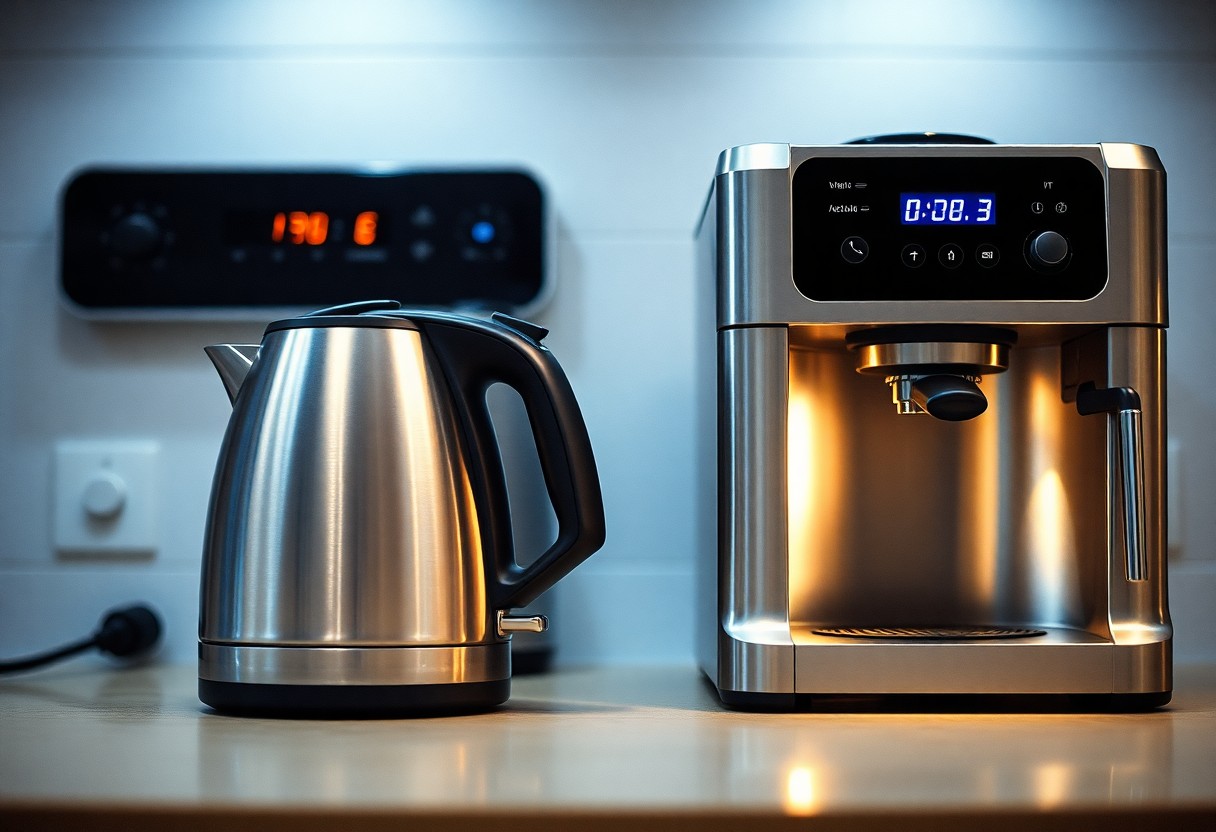
Comparative Analysis: Kettle vs. Coffee Machine
You’re probably wondering which appliance is more energy-efficient: the kettle or the coffee machine. A straightforward comparison reveals the different energy usage patterns each device exhibits. Kettles typically consume around 1500-3000 watts for quick boiling, while coffee machines might range between 800-1500 watts. For a deeper investigate how these devices stack up in terms of energy consumption, visit What Uses More Electricity Kettle Or Coffee Machine?. Here’s a summary of the key factors to consider:
| Appliance | Average Power Consumption |
|---|---|
| Kettle | 1500-3000 watts |
| Coffee Machine | 800-1500 watts |
Instant Energy Draw vs. Long-Term Use
The kettle draws a significant amount of power for a short duration, boiling water in approximately 3-5 minutes. This instantaneous energy draw leads to a spike in your electricity usage during that brief time. In contrast, coffee machines consume less power overall but can take 5-15 minutes to brew a pot, leading to a more extended albeit lower energy usage over time. Depending on your needs, one appliance may ultimately prove more energy-efficient than the other.
Real-Life Usage Scenarios and Average Consumption
Considering how you typically use these appliances can shift your perspective on energy efficiency. If you boil water frequently, a kettle may result in higher energy bills due to its higher wattage during each use. However, when brewing coffee daily, a coffee machine becomes the better choice since it operates at a lower wattage over a longer period. Your average daily consumption will largely depend on how often you use each appliance.
For instance, if you simply boil water for tea or instant noodles several times a day, the kettle’s wattage can rack up significant energy costs over time. On the other hand, using a coffee machine once a day may keep your energy consumption relatively low. You might find that making quick calculations based on your specific habits will help determine which machine is more practical for your energy-saving goals.
Factors Influencing Energy Usage
Several factors can impact the overall energy consumption of your kettle and coffee machine. Key aspects include the capacity of the appliance, the efficiency of the heating element, and the duration of use. Additionally, certain features like preheating or programmable settings can significantly alter energy demand. Here are some factors to consider:
- Appliance Efficiency
- Frequency of Use
- Water Amount Used
- Standby Energy Consumption
Knowing these details can help you make informed decisions about your energy usage when making beverages. If you’re curious about cost-effective methods, check this article where I tested if it’s cheaper to make coffee with a machine or kettle.
Frequency of Use and Duration
Your appliances’ energy consumption largely depends on how often you use them and for how long. If you boil water or make coffee multiple times a day, you may notice higher energy bills. Frequent usage causes your kettle or coffee machine to spend more time in active mode, affecting total energy consumption. Understanding your daily habits can lead to better energy management.
Water Temperature Preferences and Brew Strength
Temperature preferences play a substantial role in energy consumption. A kettle typically heats water quickly to boiling, while many coffee machines might operate at optimal brewing temperatures, requiring more energy for longer durations. If you prefer stronger coffee, adjustments in brew time and temperature may demand additional electricity, impacting overall usage.
Temperature Preferences and Energy Consumption
| Water Temperature (°C) | Energy Consumption (kWh) |
|---|---|
| 90°C (Coffee) | 0.1 kWh |
| 100°C (Kettle) | 0.15 kWh |
Understanding the relationship between water temperature and brew strength is important for optimizing energy use. For instance, if you prefer your coffee brewed at 90°C instead of boiling water at 100°C, you can save on energy. The difference may appear minimal on a single cycle, but over time, that choice can lead to significant energy savings. Adjusting your brewing methodology may not only enhance the flavor of your coffee but also minimize energy waste.
Brew Strength and Duration
| Brew Strength | Average Brewing Time (minutes) |
|---|---|
| Light | 4 |
| Regular | 6 |
| Strong | 8 |
Making Sustainable Choices: Tips for Lowering Energy Costs
Adopting sustainable practices in your kitchen can significantly cut down on your energy bills. Here are five simple tips to help you lower your energy costs:
- Use a kettle for boiling water instead of a coffee machine when making tea.
- Consider brewing coffee in larger batches to avoid repetitive energy usage.
- Choose a kettle or coffee machine with an energy-efficient rating.
- Always fill your appliances with the optimal amount of water or coffee.
- Unplug appliances when not in use to prevent phantom energy consumption.
Any step you take towards energy efficiency contributes to both cost savings and environmental sustainability.
Optimal Usage Habits
Adopting optimal usage habits will ensure your kettle or coffee machine operates efficiently. For instance, using a kettle to heat only the amount of water needed reduces energy waste. Similarly, when brewing coffee, prepare only what you intend to drink, and regularly clean your appliances to maintain peak efficiency.
Energy-Efficient Appliance Options
Investing in energy-efficient appliances makes a notable difference in your energy consumption. Look for models with the Energy Star label, as they meet strict energy efficiency guidelines. These appliances use less electricity while providing the same performance, which means you can enjoy your favorite drinks without worrying about high energy bills.
Energy-efficient kettle and coffee machine options are designed to minimize energy use while maximizing functionality. For instance, newer kettle models often feature fluctuating wattage settings, ensuring reduced energy use when boiling small amounts of water. Likewise, modern coffee machines incorporate thermal carafes that keep brewed coffee warm without a hot plate, leading to significant energy savings over time. Additionally, considering models that allow for programmable features enables you to schedule brewing during off-peak energy hours, further decreasing your costs.
To wrap up
Following this analysis, you can see that both kettles and coffee machines consume electricity, but their energy usage varies based on type and efficiency. Typically, kettles may use more energy for a quick boil, while coffee machines provide a steady draw during the brewing process. By evaluating your personal consumption habits and choosing more energy-efficient appliances, you can manage your electricity usage more effectively. This knowledge empowers you to enjoy your beverages while being mindful of your energy consumption.
FAQ
Q: Which appliance generally uses more electricity, a kettle or a coffee machine?
A: Generally, electric kettles tend to use more electricity when operated, especially since they can have wattages ranging from 1500 to 3000 watts. Coffee machines typically use around 800 to 1500 watts, depending on the model and features. The overall energy consumption also depends on the time each appliance is used, as well as the temperature settings for the kettle.
Q: How long does it take for a kettle to boil water compared to brewing coffee?
A: Boiling water in an electric kettle usually takes about 1-5 minutes depending on the kettle’s power level and the amount of water being heated. In contrast, most coffee machines take around 5-10 minutes to brew a full pot of coffee. The shorter brewing time of a kettle means that it may often use more energy in a concise timeframe than a coffee machine, despite potentially higher wattage.
Q: Can the energy consumption of a kettle vary based on its usage?
A: Yes, the energy consumption of an electric kettle is influenced by how much water you heat and the number of times you boil water. For instance, heating a full kettle will consume more electricity than boiling just a cup. Therefore, if you only need a small amount of hot water, using a kettle might not be as energy-efficient as using a coffee machine set to brew a specific amount.
Q: Is there a notable difference in energy efficiency between different coffee machine types?
A: Yes, energy efficiency can vary significantly among coffee machines. Drip coffee makers generally use less electricity than single-serve pod systems which often require more heating and processing per cup. Additionally, features like pre-heat settings, programmable timers, and auto shut-off can also affect how much energy a coffee machine consumes. Opting for more energy-efficient models can lead to better savings over time compared to traditional appliances.
Q: What are some tips for reducing the electricity consumption of both appliances?
A: To reduce electricity usage, consider only heating the amount of water you need in a kettle instead of filling it to the top. For coffee machines, brewing only the amount you will consume and regularly cleaning the appliance can improve efficiency. Using thermal carafes instead of keeping the coffee on a warming plate can also help save energy, along with using energy-efficient models certified by programs such as Energy Star.

